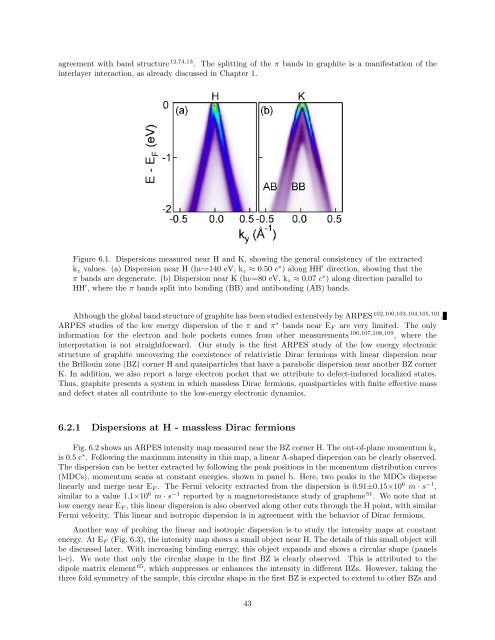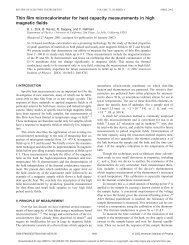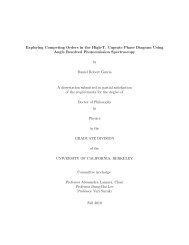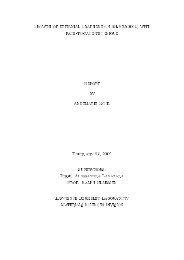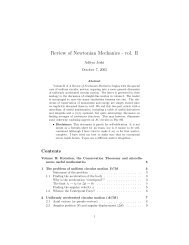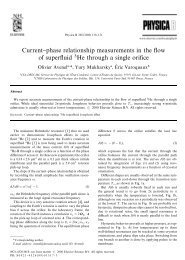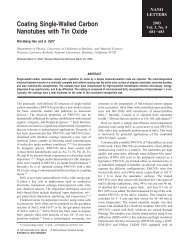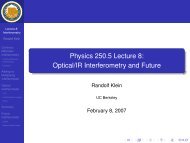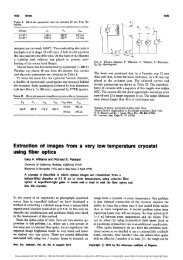Dirac Fermions in Graphene and Graphiteâa view from angle ...
Dirac Fermions in Graphene and Graphiteâa view from angle ...
Dirac Fermions in Graphene and Graphiteâa view from angle ...
You also want an ePaper? Increase the reach of your titles
YUMPU automatically turns print PDFs into web optimized ePapers that Google loves.
agreement with b<strong>and</strong> structure 12,74,13 . The splitt<strong>in</strong>g of the π b<strong>and</strong>s <strong>in</strong> graphite is a manifestation of the<br />
<strong>in</strong>terlayer <strong>in</strong>teraction, as already discussed <strong>in</strong> Chapter 1.<br />
Figure 6.1. Dispersions measured near H <strong>and</strong> K, show<strong>in</strong>g the general consistency of the extracted<br />
k z values. (a) Dispersion near H (hν=140 eV, k z ≈ 0.50 c ∗ ) along HH ′ direction, show<strong>in</strong>g that the<br />
π b<strong>and</strong>s are degenerate. (b) Dispersion near K (hν=80 eV, k z ≈ 0.07 c ∗ ) along direction parallel to<br />
HH ′ , where the π b<strong>and</strong>s split <strong>in</strong>to bond<strong>in</strong>g (BB) <strong>and</strong> antibond<strong>in</strong>g (AB) b<strong>and</strong>s.<br />
Although the global b<strong>and</strong> structure of graphite has been studied extensively by ARPES 102,100,103,104,105,101 ,<br />
ARPES studies of the low energy dispersion of the π <strong>and</strong> π ∗ b<strong>and</strong>s near E F are very limited. The only<br />
<strong>in</strong>formation for the electron <strong>and</strong> hole pockets comes <strong>from</strong> other measurements 106,107,108,109 , where the<br />
<strong>in</strong>terpretation is not straightforward. Our study is the first ARPES study of the low energy electronic<br />
structure of graphite uncover<strong>in</strong>g the coexistence of relativistic <strong>Dirac</strong> fermions with l<strong>in</strong>ear dispersion near<br />
the Brillou<strong>in</strong> zone (BZ) corner H <strong>and</strong> quasiparticles that have a parabolic dispersion near another BZ corner<br />
K. In addition, we also report a large electron pocket that we attribute to defect-<strong>in</strong>duced localized states.<br />
Thus, graphite presents a system <strong>in</strong> which massless <strong>Dirac</strong> fermions, quasiparticles with f<strong>in</strong>ite effective mass<br />
<strong>and</strong> defect states all contribute to the low-energy electronic dynamics.<br />
6.2.1 Dispersions at H - massless <strong>Dirac</strong> fermions<br />
Fig. 6.2 shows an ARPES <strong>in</strong>tensity map measured near the BZ corner H. The out-of-plane momentum k z<br />
is 0.5 c ∗ . Follow<strong>in</strong>g the maximum <strong>in</strong>tensity <strong>in</strong> this map, a l<strong>in</strong>ear Λ-shaped dispersion can be clearly observed.<br />
The dispersion can be better extracted by follow<strong>in</strong>g the peak positions <strong>in</strong> the momentum distribution curves<br />
(MDCs), momentum scans at constant energies, shown <strong>in</strong> panel b. Here, two peaks <strong>in</strong> the MDCs disperse<br />
l<strong>in</strong>early <strong>and</strong> merge near E F . The Fermi velocity extracted <strong>from</strong> the dispersion is 0.91±0.15×10 6 m · s −1 ,<br />
similar to a value 1.1×10 6 m · s −1 reported by a magnetoresistance study of graphene 51 . We note that at<br />
low energy near E F , this l<strong>in</strong>ear dispersion is also observed along other cuts through the H po<strong>in</strong>t, with similar<br />
Fermi velocity. This l<strong>in</strong>ear <strong>and</strong> isotropic dispersion is <strong>in</strong> agreement with the behavior of <strong>Dirac</strong> fermions.<br />
Another way of prob<strong>in</strong>g the l<strong>in</strong>ear <strong>and</strong> isotropic dispersion is to study the <strong>in</strong>tensity maps at constant<br />
energy. At E F (Fig. 6.3), the <strong>in</strong>tensity map shows a small object near H. The details of this small object will<br />
be discussed later. With <strong>in</strong>creas<strong>in</strong>g b<strong>in</strong>d<strong>in</strong>g energy, this object exp<strong>and</strong>s <strong>and</strong> shows a circular shape (panels<br />
b-c). We note that only the circular shape <strong>in</strong> the first BZ is clearly observed. This is attributed to the<br />
dipole matrix element 65 , which suppresses or enhances the <strong>in</strong>tensity <strong>in</strong> different BZs. However, tak<strong>in</strong>g the<br />
three fold symmetry of the sample, this circular shape <strong>in</strong> the first BZ is expected to extend to other BZs <strong>and</strong><br />
43


